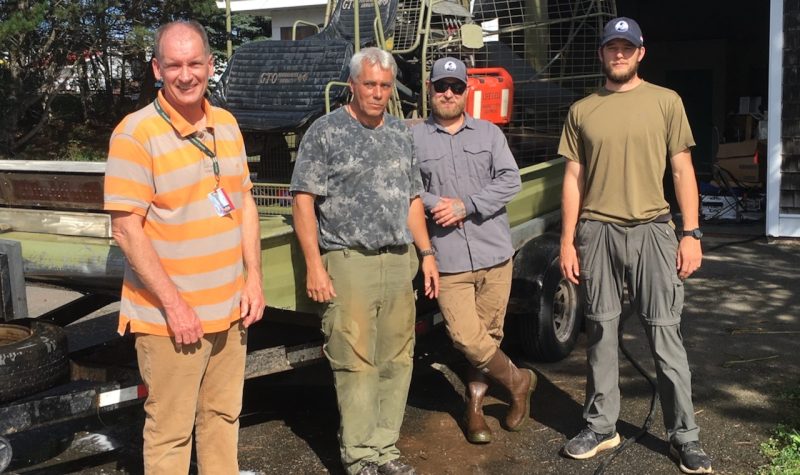You’d never know it by passing down Main Street or walking through the Sackville Waterfowl Park, but nestled in between the two, just off Waterfowl Lane, is the regional office for the Canadian Wildlife Service (CWS). That’s where CHMA found Al Hanson and his crew one day last week, cleaning and prepping their airboat to head out on another round of bird banding in the marshy wetlands of the region. Hanson is head of the Aquatic Assessment Unit with CWS, and part of the group responsible for waterfowl management in Atlantic Canada.
The airboat used by Hanson and his crew to get through thick marshland vegetation was built in Florida, and indeed looks like something you’d see in an Everglades documentary, or an episode of Swamp People. But Hanson is not after alligators, he’s after birds.
“We capture the bird, we put a band on it, and we identify the species, the sex, and the age, and then that goes into a an international database,” says Hanson. “Then when a hunter harvests that bird, they’ll report the band. And so we get an idea of what we call direct recovery, which is the number of birds that are harvested in that first season. And then we also get information on long term survival.”
Hundreds of thousands of birds have been banded and tracked in the international database to which Hanson and his crew contribute, and the collected information is used to help set parameters around the hunting season. The crew also collects data on avian flu, giving a sample of unlucky birds a COVID-like swab to test for traces of the disease.
There’s good news on that front this year, says Hanson. “Last year, there was mortality of common eiders and other species that were of concern, and then this year, we’re thankful that even though a lot of the birds are showing that they have been exposed to avian influenza, there haven’t been any mortalities. So that’s good, from a wild bird perspective.”

It’s surprising how far the noise from an airboat can travel, says Al Hanson. Photo: Erica Butler
The airboat banding operations does sometimes stir up local interest, mostly because of the noise. “It’s surprising how far that noise will travel over open areas,” says Hanson. “We’ll be on a wetland four or five miles from someone’s house, and they can hear it like we’re in their backyard.”
The noise of the airboat coupled with the time of day of the excursions (during dark, new moon phase nights in August and September,) has attracted people to come find out what’s going on.
“We try to inform local communities and police that we’re out with the airboat because it’s a different noise that most people aren’t accustomed to at night,” says Hanson. “No, it’s not aliens. It’s not someone in a stolen vehicle or someone stuck in the marsh. It’s us in the airboat.”
The bird banding program based in Sackville can visit 12 to 15 different wetlands in about an hour’s radius, says Hanson. Every year the airboat crew will tag hundreds of birds from Dorchester to Wallace, Nova Scotia to PEI. Operations happen in the two new moon periods after nesting season and before hunting season, and so will likely wrap up this week.


